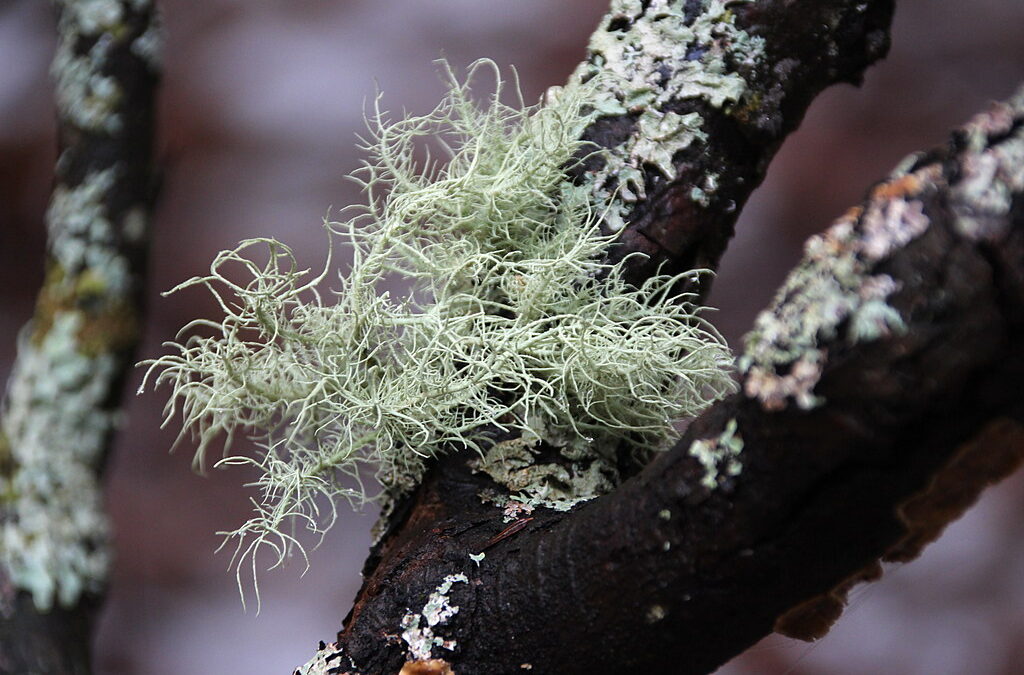By Emma Roth
Winter is usually thought of as a time with little color. Most trees are gray and naked; dead leaves are scattered below them. Grasses and herbaceous plants are brown and dry. The dark green of the evergreens and a few persistent berries bring some of the only color to the season. It is in this lack of color that one thing stands out, growing like green scales on the sides of tree trunks or exposed rocks. It is the humble lichen.
Lichen is a constant presence in the forest, but it tends to be overpowered by the bright green leaves of trees or other plants in warmer months. It isn’t until these dominant plants take a back seat that the green of the lichen shines through in winter.
A single lichen is made up of two, living so closely together that they have essentially become one. A lichen consists of an algae, or in some cases a bacteria, and a fungus, each providing a vital service to the other. The algae or bacteria are able to photosynthesize and create sugars using sunlight energy. They then give some of these sugars to their fungus companion. The fungus in turn provides a protective and moist environment for the algae to live in. This allows the lichen to grow high up on tree trunks or on exposed rock faces, away from water sources usually needed for algae to survive, and away from the nutrient rich soil that fungi often require.

I’ve often been asked if the lichens hurt the trees they grow on. Lichens can cover a large amount of a tree’s surface, but they do not harm the tree. They only use it as a surface to grow on.
Once you start looking for lichens, you can find them everywhere, in many different shapes and forms. It is estimated that 7% of Earth’s land surface is covered by lichens. The most well-known type grows on the tree trunks and branches, and on rocky surfaces. It looks like flat scales or leaves are usually pale green, but can also be dark, almost black. Some lichens grow with thin branch-like structures. These are often called reindeer lichen as the pattern of their branches resembles reindeer antlers. Sometimes, lichen will look like bright orange or yellow paint splatters on the side of a rock. They are just as happy living in cities and towns, on the sides of buildings, roofs, and fences, as they are living in nature.
Lichens provide a beautiful addition to our landscapes, but they also play a key role in the ecosystem. In a mature ecosystem, there are a few factors that can be guaranteed: producers, like plants, create food, consumers such as animals eat the producers, and decomposers turn dead organic material into soil, from which producers draw nutrients to grow and reproduce. It is a stable cycle. But what happens when disaster strikes?
Disasters are not unheard of in the natural world and can come in many forms. Wildfires, floods, and landslides can all disrupt the stability of an ecosystem. Here in Chautauqua County, the last major disruption to the ecosystem took place when the Wisconsin Glacier covered the area, over 14,000 years ago. Glaciers are ruthless and leave nothing alive in their path. They scrape hills and mountains down to the bedrock, and deposit all the sediment into the valleys as they melt.
On hills and mountains, where the soil has been removed, there is a major problem. Without soil, plants can’t grow, animals have nothing to eat, and there is nothing for the decomposers to turn into soil for plants to grow in. It seems like an impossible situation to recover from. Enter the lichen.
Lichens can do something that almost no other producers can do; they can grow on bare rock, and do not need to root into soil to draw nutrients. While it takes a long time, lichens are able to break down rocks. With the help of decomposers, dying lichens are broken down and mixed in with the weathered rock to form a thin soil layer on the rock that small plants can begin to root in. These plants can then grow and die, adding to the soil layer and allowing larger plants to grow. This continues until the soil layer is thick and healthy, and the ecosystem cycle can stabilize once again.
Lichens are vital in areas that are recovering from disastrous disturbances, but their use in the ecosystem doesn’t end there. During times of stability, lichens are a food source for a variety of animals, including insects, snails, slugs, reindeer, and caribou. Certain birds, such as hummingbirds, will use pieces of lichen in their nests, helping to camouflage the nests from predators.

While lichens may not look like much growing on trees, or in small patches on the ground, they should never be underestimated. Next time you are out and about, and see a scaly pale green patch on a tree, take a moment to appreciate the lichen and its importance to our life on land.
Audubon Community Nature Center builds and nurtures connections between people and nature. ACNC is located just east of Route 62 between Warren and Jamestown. The trails are open from dawn to dusk as is Liberty, the Bald Eagle. The Nature Center is open from 10 a.m. until 4:30 p.m. daily except Sunday when it opens at 1 p.m. More information can be found online at auduboncnc.org or by calling (716) 569-2345.
Emma Roth is a Nature Educator at Audubon Community Nature Center.


Recent Comments